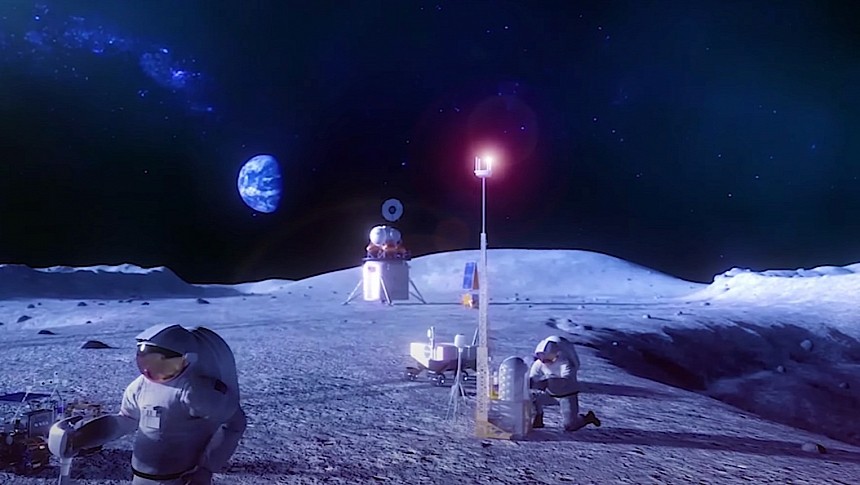It's no secret anymore that the new Moon exploration program run by the U.S., Artemis, will not limit itself to just sending people up there and getting them back, like we did with Apollo. This time, humanity is going to the Moon to stay, and that means, in a nutshell, the incipient colonization of an alien world.
It also means a lot of challenges lie ahead. That's because, unlike when it comes to short visits, semi-permanent or permanent stays on the Moon require a lot of logistics to keep a base up and running.
One of the most important aspects to take into consideration is the generation and distribution of power in a place that experiences freezing, weeks-long nights.
Although the Artemis missions take center stage when it comes to our renewed interest in the Moon, NASA has a bag full of side projects and programs meant to advance our push for a lunar civilization. As far as energy is concerned, the program is called Watts on the Moon Challenge.
Launched in September 2020, it aims to "come up with new technologies to address" power generation and distribution on the Moon. It's a fairly advanced program and NASA pushed it even further earlier this week by announcing the short list of participating partners.
After it kicked off this Phase 2 Level 2 in the summer of last, NASA now trimmed down the list of competing ideas even further, and announced the names of the ones that will move to Phase 2 Level 3 (and receive further funding of $400,000 each).
First on the list is the Ohio State University in Columbus and its Electric Moon idea. It is centered around cable transmission of power, backed by modular, multilevel conversion. It's a kind of cable transmission that proved during testing it is possible to move power "with an energy load large enough to support a television and sound system."
The University of California, Santa Barbara, proposes something called the High Efficiency Long-Range Power Solution. The idea of this group aims to allow power hardware to operate within a wide temperature range, solving some of the issues that come from lunar day and night conditions.
The Michigan Technological University in Houghton came up with the idea of adapting rovers to move around the surface of the Moon and deliver power to where it's needed by means of a battery. Called Tethered Mechanism for Persistent Energy Storage and Transmission (TEMPEST), the concept should literally connect power infrastructure elements by means of rovers.
The single private company accepted in this Phase, Orbital Mining Corporation, is working on a DC-to-DC converter system capable of surviving the lunar nights.
All four groups have until 2024 to get something ready for testing in a simulated lunar environment. At the end of the tests, two winners will be declared and take will take home a total of $1.5 million in NASA prizes.
One of the most important aspects to take into consideration is the generation and distribution of power in a place that experiences freezing, weeks-long nights.
Although the Artemis missions take center stage when it comes to our renewed interest in the Moon, NASA has a bag full of side projects and programs meant to advance our push for a lunar civilization. As far as energy is concerned, the program is called Watts on the Moon Challenge.
Launched in September 2020, it aims to "come up with new technologies to address" power generation and distribution on the Moon. It's a fairly advanced program and NASA pushed it even further earlier this week by announcing the short list of participating partners.
After it kicked off this Phase 2 Level 2 in the summer of last, NASA now trimmed down the list of competing ideas even further, and announced the names of the ones that will move to Phase 2 Level 3 (and receive further funding of $400,000 each).
First on the list is the Ohio State University in Columbus and its Electric Moon idea. It is centered around cable transmission of power, backed by modular, multilevel conversion. It's a kind of cable transmission that proved during testing it is possible to move power "with an energy load large enough to support a television and sound system."
The University of California, Santa Barbara, proposes something called the High Efficiency Long-Range Power Solution. The idea of this group aims to allow power hardware to operate within a wide temperature range, solving some of the issues that come from lunar day and night conditions.
The Michigan Technological University in Houghton came up with the idea of adapting rovers to move around the surface of the Moon and deliver power to where it's needed by means of a battery. Called Tethered Mechanism for Persistent Energy Storage and Transmission (TEMPEST), the concept should literally connect power infrastructure elements by means of rovers.
The single private company accepted in this Phase, Orbital Mining Corporation, is working on a DC-to-DC converter system capable of surviving the lunar nights.
All four groups have until 2024 to get something ready for testing in a simulated lunar environment. At the end of the tests, two winners will be declared and take will take home a total of $1.5 million in NASA prizes.









